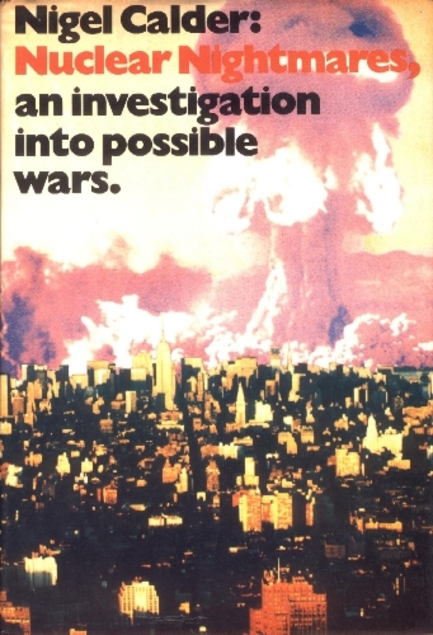
Nuclear Nightmares: an Investigation into Possible Wars
Nigel Calder
168 pages including index
published in 1979
To distract myself from the current state of the covid-19 ravaged world, I read this cheery little treatise on the machinery for nuclear war. Many many years ago, sometime in the early eighties, I bought the Dutch edition for a guilder at a church fair. And boy was it worth it: I had nightmares for years. Not that you needed much to have nuclear nightmares in the early eighties; if you ever wonder why late Gen-Xers and early millennials are so cynical, it’s because we grew up with the idea that the nuclear holocaust could happen every minute just because some world leader was a bit too gung ho. Or some seemingly small mistake makes the Soviets think an American missile barage is on its way and this time there isn’t a junior officer brave enough to wait for confirmation before he launches a counterstrike…
But that is not the nightmare that Nigel Calder sketches in this book. His is a technocratic world, a world of rational men tending carefully balanced machinery designed to deliver megadeath on the enemy. Men who do not want to murder millions of people, but who will do so if and when it is asked of them. A world full of acronym littered dry, bureaucratic language that conceals the existentialist horror at the heart of it. An orderly world that calmly makes plan to destory or cripple the enemy’s ability to wage nuclear war, that worries about the vulnerability of MIRVED Minutemen III and whether they were safe enough and good enough to hit back at the Soviets after a first strike. Can we depend on the survivability of our systesm to give our leaders time enough to think about whether they want to strike back?
And then no two years later you got a fake cowboy in the White House talking about the Evil Empire, mentally disintegrating on the job and joking on live tv that the bombs will drop in five minutes. All while promoting implausible future wonderwaffen that would make America safe from nuclear attack forever.
And on the other side, a succesion of half dead paranoid survivors of Stalin convinced the west could and would attack them any minute. For all the Western hawks worrying about Soviet plans for world domination, more concerned with Dmitri in Leningrad finally getting a fridge and colour television, but worried that the imperialistic west was plotting to abuse a period of weakness.
But even when Calder was writing his book, he was chronicling an illusion. The neat, orderly world of calm dispassionate technocrats making brilliant plans for the end of the world was fake. The reality is shown in a much more recent book, Eric Schlosser’s Command and Control. In reality, there were at least half a dozen incidents in which an American nuclear weapon would’ve detonated on American ground but for a bit of luck, where nuclear bombs are safeguarded with nothing more than a simple bicycle lock, where instead of intricate control mechanisms and the decision to launch made only at the highest level, any Italian soldier could’ve launched a leased American nuclear missile because there were no safeguards.
In hindsight, I’m not sure if Schlosser’s reality wouldn’t have frightened me more than Calder’s already terrifying portrait of a mechanism that could sleepwalk into nuclear war. What comforts me is that the actual military commanders involved at the time seemed to think a nuclear war would never happen, that the entire idea of the Cold War turning hot was a fantasy. Just read the reactions of senior Warsaw Pact commanders (PDF) to the idea of actually going to war and how likely that had been. If only I had know that in 1984, having nightmares every time the news was about arms limitation negotiations or tensions in Europe.
Of course, within a decade this whole system would be obsolete, that existential threat vanquished, the whole complex revealed to be irrelevant, as the people of Eastern Europe rose up and overthrow those seemingly invincible ‘socialist’ dictatorships. That seventies idea that the only choice the world had was between an uneasy detente between twho hostile systems or nuclear annihilation that sets the tone for Calder’s book was shown up to be false by the actions of ordinary people, completely powerless to do what it was built for, safeguard the existence of its masters’ world system.
The late 1970s were a strange time, the Soviet Union slowly rotting from the inside out while the lunatics of Team B –the people who thirty years later would bring you the War on Iraq — were busy screaming their heads off that America was doomed because the commies were so much better armed and so much more ruthless. All that was fake, but at the time we didn’t know better. All the clever clogs and military commentators really thought that the West was losing the Cold War, that our vulnerabilities meant a nuclear war was inevitable if we didn’t want to go Red. So much of eighties pop culture is steeped in that American paranoia, from Red Dawn to Pournelle’s CoDominion stories where detente was interstellar. Meanwhile here in Europe we grew up knowning our towns were just a megaton apart from each other and we were busy cataloging the likely nuclear targets near our home towns.
A real great time to grow up in. Never thought I’d make it to adulthood, but here we are.
No Comments